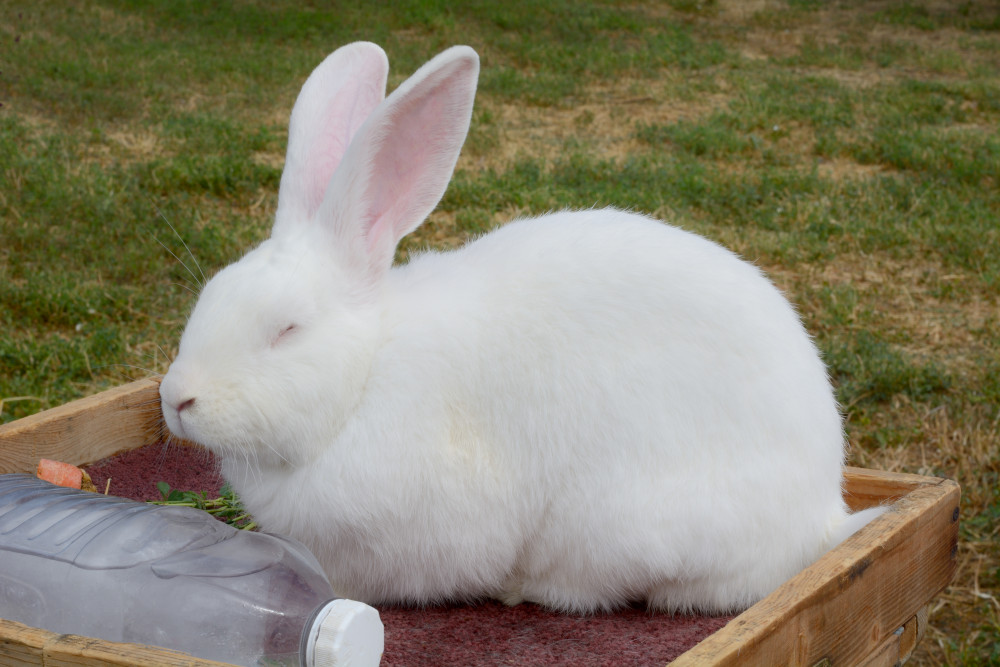
Many people mistakenly believe that, because feral rabbits seem to thrive in Australia, rabbits must be heat tolerant. The truth is that the only way wild rabbits can survive in the hot Australian climate is because of their crepuscular activity, i.e., they are most active in the cool hours of the morning and evening. In the middle of the day, when temperatures are soaring, they seek shelter in burrows and warrens where the temperature is so much cooler.
Captive rabbits face a different challenge, especially if they do not have adequate shelter from the heat. Heat stress is a condition where rabbits are unable to maintain a balance between heat production and emission. This occurs when different factors interact:
- High ambient temperatures
- High humidity
- Radiant heat (sunlight)
- Poor ventilation and lack of a breeze
The optimal temperature range of rabbits is 15–25°C, and the optimal humidity is 55%–60%. Heat stress can occur when the ambient temperature is higher than 30°C. When the temperature is higher than 35°C, rabbits cannot regulate their body temperature, and can develop heatstroke.
What does heat stress look like?
Rabbits do not display symptoms of illness unless they are in real trouble. Check your rabbit carefully at least a couple of times a day to spot any early signs of heat stress, such as:
- Drooling or salivating
- Panting and taking short shallow breaths
- Overall weakness and lethargy
- Reddening and warmth of the ears
- Wetness around the nose
As heatstroke develops, the rabbit may have fits or seizures, or even lose consciousness.
What should I do if I think my rabbit has heatstroke?
If your rabbit is showing any of these signs, please talk to your vet immediately. In the meantime, there are some immediate things that you can do to help try and cool your rabbit down. It’s really important that you do this slowly; this will avoid your rabbit going into shock and making the situation worse.
- You should never pour water over your rabbit.
- Place a damp towel over the enclosure.
- Allow them to drink small amounts of cool water.
- Gently wipe cool water on their ears.
- Move their enclosure (if you can) so it’s in a cooler place or move them to a cooler (secure) place if moving the enclosure is not an option.
How can I prevent heat stress?
As with all conditions, prevention is better than cure. There are a few simple steps that you can take that will ensure your rabbits stay safe.
Shade
Plenty of shade is a must, indoors or outdoors.
- If it is a very hot day, consider bring your bunnies inside into the air conditioning – they will thank you for it!
- Rabbits should never be housed in direct sunlight.
- If it’s not possible for their enclosure to be in the shade, then you need to provide plenty of options for shade within the enclosure. This could be a beach umbrella, a towel, or some tarpaulin.
- Provide a tunnel or cardboard box for both shade and some entertainment.
Water
Without plenty of water on a really hot day, your rabbits will quickly dehydrate.
- You should provide a couple of different water sources, such as a bowl and a bottle.
- Check bottles regularly to ensure they aren’t blocked.
- Change the water a minimum of twice a day, so your rabbits will always have access to clean, cool water.
- A frozen bottle of water wrapped in a towel is a great way to help your rabbits keep cool.
Ventilation
Making sure your rabbits have adequate ventilation is vital, regardless of whether they are indoors or outdoors.
- If your rabbits’ enclosure is in a shed or outhouse, you could safely open a door or window to allow a natural breeze to pass through. Don’t allow a cool breeze to become an uncomfortable draft.
- If there is little or no natural breeze (indoors or outdoors), a small battery-operated fan can help provide some ventilation to your rabbit’s enclosure. Always position it so that your rabbit can move away from the breeze should they have had enough.
Grooming
Rabbits with longer fur (and mats) will heat up quicker and lose heat slowly.
- Ensure that your rabbit is well-groomed – brush it regularly to remove loose fur.
- Trim their coat shorter in the hotter months. Don’t shave them bare – a short coat can insulate against the sun and the heat.
References
1. Oladimeji AM, Johnson TG, Metwally K, Farghly M, Mahrose KM (2022) Environmental heat stress in rabbits: implications and ameliorations. Int J Biometeorol.
2. Jenkins JR (2001) Rabbit Behavior. Vet Clin North Am Exot Anim Pract 4:669–679
3. Varga M, Harcourt-Brown F (2014) Textbook of Rabbit Medicine, 2nd ed. Elsevier
